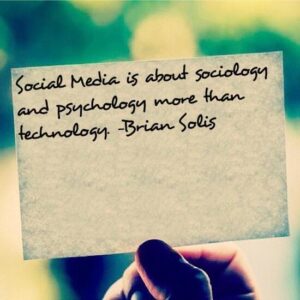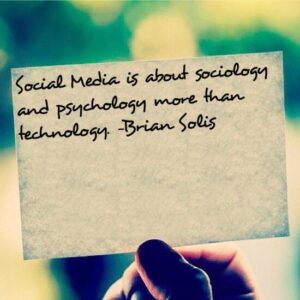
Social networks are propelled by the connections, conversations, and gestures between active netizens. The success and vitality of each network is rooted in its capacity to expand social graphs and nurture communication and shared experiences. As such, Twitter announced a new feature to help you discover who to follow.
The new “Suggestions for You” service is simple, but powerful. It not only introduces you to like-minded people, it empowers you to more effectively curate your connections and as such, your overall Twitter experience.

After reading Julia Angwin’s fantastic article, “The Web’s New Gold Mine: Your Secrets,” I realized that I was not connected to her on Twitter. Upon following her, I was introduced to several similar accounts that Twitter’s new human algorithm (as I call it) factors people you follow in addition to the people they follow and presents a qualified list for your consideration.
Suggestions for You is not unlike the Suggestions feature we’ve enjoyed in Facebook for quite some time.

From Social Networks to Social Nicheworks
I believe that social networking is rapidly evolving from relationships to relations-based connectivity where context prevails over association. With the world literally at our fingertips, we are learning that we are in control of defining our online experiences and as such, curating who we follow contributes to the relevance of our social streams. It’s less about who we know, and more about who we want to know and who we should know based on the shared topics, interests, and themes that form the ties that bind us.
Facebook and now Twitter are helping us refine our experience. Over time, our social networks will transform into contextually-based social nicheworks.
Dunbar’s Number to Social Graph Theory
British anthropologist Robin Dunbar’s famous number of 150 (estimated) is often cited as a benchmark for online social connectivity. Dunbar’s number represents the maximum number of social relationships we as individuals can manage to a stable extent. Ironically, Facebook states that the average person maintains a social graph of roughly 130 friends. As intelligent algorithms introduce us to people who share our passions and interests, I believe that the average number will double every year. While staying true to Dunbar’s number, we will extend core relationships into “relations” where we are less vested in the cultivation of these new connections. Essentially, our social graphs will expand from those we know in first-degree relationships to now focus on those we align with intellectually and emotionally through second and third-degree relationships.
Do you see foresee a change in how you connect with people online?
Connect with Brian Solis on Twitter, LinkedIn, Tumblr, Facebook
___
Please consider reading, Engage!: It will help you find answers to your questions…

___
Get Putting the Public Back in Public Relations and The Conversation Prism:


___
Image Credit: ShutterStock





Hey Brian – great post and good question. I think it all comes down to how we relate in general and how we think we can “transform” the same type of relation to an online context. In fact it's a question I struggle with a lot. I think that the answer to that question in fact is “mission critical” to a lot of companies who are in the need to reinforce their competitiveness in the 21th century. How to you build trust in an online world to a reallife person? Any idea's?
All the best
Hans Henrik
Hans, I certainly have ideas and also experiences tied to each. Have spent a great deal of time and energy identifying these nicheworks for brands. The insight and the ensuing connections are incredible…the trick is to now figure out how to fund sustaining research and interaction and draw connections to business metrics (that's what I'm working on now).
Hi Brian,
I agree with you that Facebook and Twitter are attempting to assist their members to find others wtih whom they share interests. I look at it in terms of the, more or less, traditional distinction between online communities and social networks. The overall developmental trend is to attempt an integration of the affordances of each type of social software architecture. I disagree with you on the elasticity of the limits implied by the Dunbar Number. I guess that is because I don't think there are any intelligent algorithms. I do think there are algorithms that allow humans to scale their attention to those they connect with online.
I understand that Robin Dunbar is currently doing his own research on this topic, so perhaps he will offer some insight in the near future.
Larry
Indeed Larry. I believe that the elasticity comes at a price in online networking…a shift from relationships to relations (or as Umair refers to them…”thin relationships) http://blogs.hbr.org/haque/2010/03/the_social_m…
The difference is however, intention. To quote Eric Claption, “it's in the way that you use it.”
Brian, all good points and I would agree that most folks using social media tools already group their connections either formally or informally. Keep in mind Dunbar's research is all about our cognitive abilities based on anthropological research. In this case individual changes most likely won't increase a persons ability to manage more connections. Dunbar does address your point that there are situations where we can manage a larger number of connections but this has much to do with external influences. In his “Social Brain Hypothesis” he refers to groupings of individuals who are able to manage more or less connections as Camps, Tribes and Clans (doesn't that sound familiar and yet he wrote it back in 1998) and does indeed state that each has a different ability to manage relationships.
What is the step beyond the next step? Folks who remove the context of an actual connection and rely on an assumption that we are all connected simply by being online thus removing the desire to “feel” connected. (e.g. you are a resource to a need I have, we are both online, viola!). This is where I would argue we are truly heading.
Hi Brian,
I agree with everything you said now how do I find the tool and use it?
Warmly,
Lauren McMullen
@laurenamcmullen
Brian: I think the “change” you refer to will be more of a “blend” instead as we seek more opportunities to mix our daily life with our online persona. Before you needed at least a laptop to update your Facebook status; now, two clicks away on your phone let you do that. Barriers are coming down. Thanks for the link to Angwin's article, truly fantastic. Cheers!
Paul
@paulylacosta
I agree the new suggestions feature is remarkable and everyday I am adding new people on my following list and I feel that with time the list of people I follow will get more focused and thereby allowing me to finetune the twitter chat even better. Thanks for sharing the above article. It is always a pleasure to read your posts.
When you are mentioning Dunbar's 150, it's important to add that for irregular people, such as online marketers and merchants, it is much more important,even nicheworks-wise, tho have much more than 150. It is astonishingly difficult to achieve mainstream success,nonetheless when you have 150 friends on facebook. Waiting for a post about social media marketing for the small businesses around here-how to make you pizza place or dry cleaner a name in the game of your neighborhood. Think you're up for it, Brian?